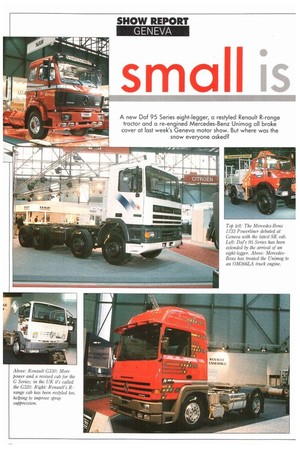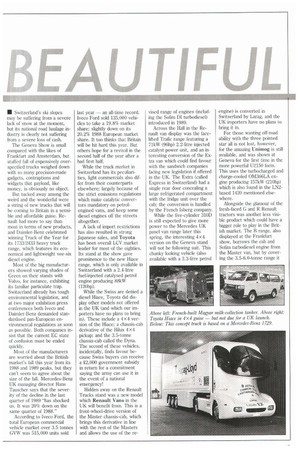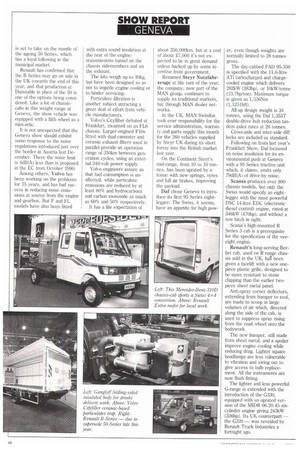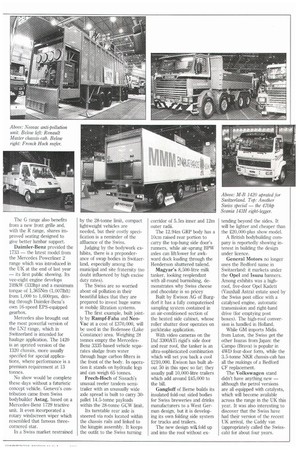small is
Page 48

Page 49

Page 50

Page 51

If you've noticed an error in this article please click here to report it so we can fix it.
EALITIFUL
A new Daf 95 Series eight-legger, a restyled Renault R-range tractor and a re-engined Mercedes-Benz Unimog all broke cover at last week's Geneva motor show. But where was the snow everyone asked?
• Switzerland's ski slopes may be suffering from a severe lack of snow at the moment, but its national road haulage industry is clearly not suffering from a severe loss of cash.
The Geneva Show is small compared with the likes of Frankfurt and Amsterdam, but stuffed full of expensively overspecified trucks weighed down with so many precision-made gadgets, contraptions and widgets that payload, like money, is obviously no object.
But tucked away among the weird and the wonderful were a string of new trucks that will be coming to Britain in a sensible and affordable guise. Renault had more to say than most in terms of new products, and Daimler-Benz celebrated winning Truck of the Year for its 1733/2433 heavy truck range, which features its economical and lightweight vee-six diesel engine.
Most of the big manufacturers showed varying shades of Green on their stands with Volvo, for instance, exhibiting its familiar particulate trap. Switzerland already has tough environmental legislation, and at two major exhibition press conferences both lveco and Daimler-Benz demanded standardised pan-European environmental regulations as soon as possible. Both companies insist that the current EC state of confusion must be ended quickly.
Most of the manufacturers are worried about the British market's fall this year from its 1988 and 1989 peaks, but they can't seem to agree about the size of the fall. Mercedes-Benz UK managing director Hans Tauscher says that the severity of the decline in the last quarter of 1989 "has shocked us. It was 20% down on the same quarter of 1988."
According to lveco Ford, the total European commercial vehicle market over 3.5 tonnes (NW was 515,000 units sold last year — an all-time record. Iveco Ford sold 135,000 vehicles to take a 19.8% market share; slightly down on its 20.2% 1988 European market share. It too thinks that Britain will be hit hard this year. But others hope for a revival in the second half of the year after a bad first half.
While the truck market in Switzerland has its peculiarities, light commercials also differ from their counterparts elsewhere; largely because of the strict emissions regulations which make catalytic convertors mandatory on petrolengined vans, and keep some diesel engines off the streets altogether.
A lack of import restrictions has also resulted in strong Japanese sales, and Toyota has been overall LCV market leader for most of the eighties. Its stand at the show gave prominence to the new Hiace range, which is only available in Switzerland with a 2.4-litre fuerinjected catalysed petrol engine producing 88kW (120hp).
While the Swiss are denied a diesel Hiace, Toyota did display other models not offered in the UK (and which our importers have no plans to bring in). These include a 4 x4 version of the Hiace; a chassis-cab derivative of the Hilux 4x4 pickup; and the 3.5-tonne chassis-cab called the Dyna. The second of these vehicles, incidentally, finds favour because Swiss buyers can receive a £2,000 government subsidy in return for a commitment saying the army can use it in the event of a national emergency!
Hidden away on the Renault Trucks stand was a new model which Renault Vans in the UK will benefit from. This is a front-wheel-drive version of the Master chassis-cab, which brings this derivative in line with the rest of the Masters and allows the use of the re vised range of engines (including the Sofim DI turbodiesel) introduced in 1989.
Across the Hall in the Renault van display was the facelifted Trafic range featuring a 71kW (96hp) 2.2-litre injected catalyst power unit, and an interesting conversion of the Extra van which could find favour with the sandwich companies facing new legislation if offered in the UK. The Extra (called Express in Switzerland) had a single rear door concealing a large refrigerated compartment with the fridge unit over the cab; the conversion is handled by the French Isberg company.
While the five-cylinder 310D is still expected to give more power to the Mercedes UK panel van range later this spring, the interesting 4 x4 version on the Geneva stand will not be following suit. This chunky looking vehicle (also available with a 2.3-litre petrol engine) is converted in Switzerland by Larag, and the UK importers have no plans to bring it in.
For those wanting off-road ability with the three pointed star all is not lost, however, for the amazing Unimog is still available, and was shown at Geneva for the first time in the more powerful U2150 form. This uses the turbocharged and charge-cooled 0M366LA engine producing 157kW (210hp) which is also found in the LN2based 1420 mentioned elsewhere
Alongside the glamour of the fresh-faced G and R Renault tractors was another less visible product which could have a bigger role to play in the British market. The B range, also displayed at the Frankfurt show, borrows the cab and Sofim turbodiesel engine from the Master van, but by covering the 3.5-6.0-tonne range it is set to take on the mantle of the ageing 50 Series, which has a loyal following in the municipal market.
Renault has confirmed that the B Series may go on sale in the UK towards the end of this year, and that production at Dunstable in place of the 50 is one of the options being considered. Like a lot of chassiscabs in this weight range at Geneva, the show vehicle was equipped with a fifth wheel as a mini-artic.
It is not unexpected that the Geneva show should exhibit some response to the noise regulations introduced just over the border in Austria last December. There the noise limit is 4dB(A) less than is proposed in the EC from October 1990.
Among others, Volvo has been working on the problems for 15 years, and has had success in reducing noise emissions at source from the engine and gearbox. But F and FL models have also been fitted with extra sound insulation at the rear of the engine/ transmissions tunnel on the chassis sidemembers and on the exhaust.
The kits weigh up to 30kg, but have been designed so as not to impede engine cooling or to hinder servicing.
Particulate filtration is another subject attracting a great deal of effort from vehicle manufacturers.
Volvo's Cityfilter debuted at Frankfurt, mounted on an FL6 chassis. Larger-engined FlOs fitted with dual-cannister and ceramic exhaust filters used in parallel provide an operation range of 350km between generation cycles, using an external 240-volt power supply.
Volvo engineers assure us that fuel consumption is unaffected, while particulate emissions are reduced by at least 80% and hydrocarbons and carbon monoxide as much as 60% and 50% respectively.
It has a life expectation of about 350,000km, but at a cost of about £7,000 it's not expected to be in great demand unless backed up by some incentive from government.
Renamed Steyr Nutzfahrzeuge at the turn of the year, the company, now part of the MAN group, continues to supply its traditional markets, but through MAN dealer networks.
In the UK, MAN Swindon took over responsibility for the service administration, warranty and parts supply this month for the 260 vehicles supplied by Steyr UK during its short fon-ay into the British market last year.
On the Continent Steyr's mid-range, from 10 to 16 tonnes, has been uprated by a tonne with new springs, tyres and full air brakes, improving the payload.
Daf chose Geneva to introduce its first 95 Series eightlegger. The Swiss, it seems, have an appetite for high pow
er, even though weights are normally limited to 28 tonnes gross.
The day-cabbed FAD 95.350 is specified with the 11.6-litre ATi turbocharged and chargecooled engine which delivers 282kW (383hp), or 10kW/tonne (13.7hp/ton). Maximum torque is given as 1,526Nm (1,1251bft).
All-up design weight is 34 tonnes, using the Daf 1,3551 double-drive hub reduction tandem axles rates at 26 tonnes.
Cross-axle and inter-axle diff locks are included as standard.
Following on from last year's Frankfurt Show, Daf focussed on noise insulation for its environmental push at Geneva with a 95 Series tractive unit which, it claims, emits only 79dB(A) of drive-by noise.
Scania produces over 800 chassis models, but only the Swiss would specify an eightlegger with the most powerful DSC 14-litre EDC (electronic diesel control) engine, rated at 346kW (470hp), and without a tow hitch in sight.
Scania's high-mounted R Series 3 cab is a prerequisite for the specification of the veeeight engine.
Renault's long-serving Berliet cab, used on R range chassis sold in the UK, hal been given a facelift with a new onepiece plastic grille, designed to be more resistant to stone chipping than the earlier twopiece sheet metal panel.
Anti-spray corner deflectors, extending from bumper to roof, are made to scoop in large volumes of air which, directed along the side of the cab, is used to suppress spray rising from the road wheel onto the bodywork.
The new bumper, still made from sheet metal, and a spoiler improve engine cooling while reducing drag. Lighter square headlamps are less vulnerable to vibration and swing out to give access to bulb replacement. All the instruments are now flush fitting.
The lighter and less powerful G-range is extended with the introduction of the G330, equipped with an uprated version of the M1DR 06.20.45 sixcylinder engine giving 243kW (326hp). Its UK counterpart — the G320 — was revealed by Renault Truck Industries a fortnight ago.
The G range also benefits from a new front grille and, with the R range, shares improved seating designed to give better lumbar support.
Daimler-Benz provided the 1713 — the latest model from the Mercedes Powerliner 2 range which was introduced in the UK at the end of last year — its first public showing. Its vee-eight engine develops 249kW (333hp) and a maximum torque of 1,365Nm (1,007lbft) from 1,000 to 1,600rpm, driving through Daimler-Benz's own 16-speed EPS-equipped gearbox.
Mercedes also brought out the most powerful version of the LN2 range, which in Switzerland is intended for haulage application. The 1420 is an uprated version of the 1320 chassis, more usually specified for special applications, where performance is a premium requirement at 13 tonnes.
No show would be complete these days without a futuristic concept vehicle. Geneva's contribution came from Swiss bodybuilder Astag, based on a Mercedes-Benz 1729 tractive unit. It even incorporated a rotary windscreen wiper which resembled that famous threecornered star.
In a Swiss market restrained by the 28-tonne limit, compact lightweight vehicles are needed, but their costly specification is a reminder of the affluence of the Swiss.
Juclifmg by the bodywork exhibits, there is a preponderance of swap bodies in Switzerland, especially among the municipal and site fraternity (no doubt influenced by high excise duty rates).
The Swiss are so worried about oil pollution in their beautiful lakes that they are prepared to invest huge sums in mobile filtration systems.
The first example, built jointly by Rampf-Faba and NeoVac at a cost of £370,000, will be used in the Bodensee (Lake Constance) area. Weighing 28 tonnes empty the MercedesBenz 3335-based vehicle separates sludge from water through huge carbon filters in the front of the body. In operation it stands on hydraulic legs and can weigh 65 tonnes.
Frech-Hoch of Sissach's unusual reefer tandem semitrailer with an unusually wide axle spread is built to carry 30pallet 14.5-tonne payloads within the 28-tonne GCW limit.
Its turntable rear axle is steered via rods located within the chassis rails and linked to the kingpin assembly. It keeps the outfit to the Swiss turning corridor of 5.5m inner and 12m outer radii.
The 12.94m GRP body has a 10cm raised rear portion to carry the top-hung side door's runners, while air-sprung BPW axles can lift/lower for awkward dock loading through the Henderson shuttered tailend.
Magyar's 8,500-litre milk tanker, looking resplendant with all-round burnishing, demonstrates why Swiss cheese and chocolate is so pricey Built by Ewison AG of Burgdorf it has a fully computerised sampling system contained in an air-conditioned section of the heated side cabinet, whose roller shutter door operates on parkbrake application.
With video cameras on the Daf 3300ATi rigid's side door and rear roof, the tanker is an ultra-sophisticated combination which will set you back a cool £210,000. Ewison has built about 50 in this spec so far; they usually pull 10,000-litre trailers which add around £45,000 to the bill.
Gangloff of Berne builds its insulated fold-out sided bodies for Swiss breweries and drinks manufacturers to a West German design, but it is developing its own folding side system for trucks and trailers.
The new design will. fold up and into the roof without ex tending beyond the sides. It will be lighter and cheaper than the £20,000-plus show model.
A British bodybuilding company is reportedly showing interest in building the design under licence.
General Motors no longer uses the Bedford name in Switzerland: it markets under the Opel and Isuzu banners. Among exhibits was a highroof, five-door Opel Kadett (Vauxhall Astra) estate used by the Swiss post office with a catalysed engine, automatic transmission and right-hand drive (for emptying post boxes). The high-roof conversion is handled in Holland.
While GM imports Midis from Luton, the Swiss get the other Isuzus from Japan: the Campo (Brava) is popular in 4W1) four-door form, while the 3.5-tonne NKR chassis-cab has all the makings of a Bedford CF replacement.
The Volkswagen stand didn't have anything new — although the petrol versions are all equipped with catalysts, which will become available across the range in the UK this year. It was also interesting to discover that the Swiss have had their version of the recent UK arrival, the Caddy van (appropriately called the Swisscab) for about four years.




































































































































